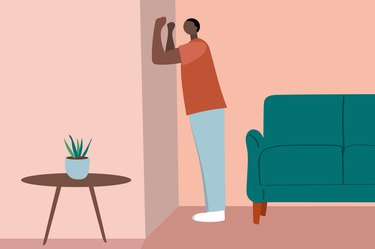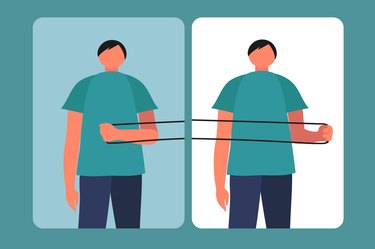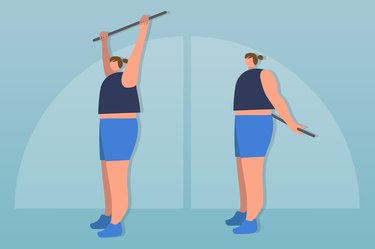

You might not be familiar with your serratus anterior, but you use it for everyday movements like grabbing something overhead. It's the fan-shaped muscle on each side of your rib cage that's responsible for drawing your shoulder blades apart and upwardly rotating them.
But weakness in this muscle can lead to shoulder pain and injury.
Video of the Day
"When your serratus anterior is weak and you have difficulty activating it, you increase your risk for shoulder injuries due to your shoulder and/or shoulder blade being in a not-so-good position," Grayson Wickham, DPT, CSCS, physical therapist and founder of Movement Vault, tells LIVESTRONG.com.
So if you're having issues grabbing something from the top shelf or lifting your baby from the crib, then you want to add the serratus anterior wall slide to your exercise routine. It not only helps prevent shoulder pain and injury but also helps improve mobility.
- What is a serratus wall slide? Also known as lower trap wall slides, this shoulder mobility exercise opens up the space between your shoulder blades and involves moving your scapula away from your spine, aka shoulder protraction. It's done standing with your forearms against a wall at shoulder height, unlike wall slides, where your shoulders are against a wall.
- What muscles does the serratus wall slide work? In addition to being one of the best serratus anterior exercises, it also activates your lower trapezius muscles — which run over the back of your neck, across your shoulder blades and down to the middle of your spine.
- Who should do this exercise? Unless you have a shoulder injury or are otherwise unable to perform this move, most people should incorporate this move in their mobility routine.
- What does serratus anterior pain feel like? People with serratus anterior injuries often experience pain in their shoulder blades, as well as in their chest or ribs, according to Stat Pearls. It may even feel tender when taking a deep breath, or you may have a hard time raising your arm(s) overhead.
How to Do a Serratus Wall Slide With Proper Form
- Stand facing a wall with your feet shoulder-width apart or step out slightly with one foot.
- Place your forearms on the wall at shoulder height, thumbs facing you.
- This is the important part: Protract your shoulder blades to activate your serratus anterior muscles. To do this, press your forearms into the wall and think about pushing your upper back away from the wall while keeping your forearms on the wall. Or think about bringing your shoulders together in the front.
- Pull your rib cage down as you tighten your abdominal muscles. This is the starting position.
- Maintaining this protracted position, slowly slide your arms up the wall as far as you can go.
- Only go up as far as you can maintain that protracted position. It may be a small range of motion at first.
- Then, bring them back down to the starting position.
Warning
If you have shoulder pain and/or difficulty raising your arms overhead, consult your doctor or a physical therapist to ensure this exercise is right for you. You shouldn't feel any pain with this exercise, so if you do, stop doing it and talk to your doctor.
Watch the Full Tutorial
3 Serratus Wall Slide Variations for an Added Challenge
Once you've mastered the basic serratus wall slide, Wickham shares three variations to further challenge yourself for a strong and stable scapula.
1. Serratus Wall Slide With Foam Roller
This wall slide variation challenges your serratus muscles to hold the foam roller in place against the wall. In addition, it provides a good visual to track as you work your arms in that overhead motion.
- Stand facing the wall.
- Place your forearms on the foam roller on the wall, with your thumbs pointing back.
- Start with arms at 90-degree angles.
- Brace your core and think about pulling your ribcage down.
- Spread your shoulder blades apart by pushing into the foam roller.
- Roll your forearms up and down the foam roller, keeping your core tight and your forearms pressed into the foam roller throughout the motion.
2. Serratus Slide With Medicine Ball
Once you've mastered the foam roller, the medicine ball will recruit your core even more because the weight is greater. This exercise also works your serratus anterior in a different way, as your arms are slightly closer together than during the other exercises.
- Stand facing the wall.
- Place your forearms on the medicine ball on the wall, thumbs facing back.
- Start with arms at 90-degree angles.
- Tighten your core and think about pulling your ribcage down.
- Spread your shoulder blades apart by pushing into the medicine ball.
- Roll your forearms up and down on the medicine ball, keeping your core tight and your forearms pressed into the ball throughout the movement.
Tip
Since the medicine ball adds more resistance to the serratus wall slide, start with a light medicine ball and work your way up.
3. Serratus Wall Slide With Resistance Band
Using a resistance band for the serratus wall slides is a great way to build more strength in this important muscle. It also allows you to monitor your progress, as you can use different levels of resistance as you get stronger.
- Take a resistance band and wrap it around your back and loop each end into a thumb.
- It should sit below your shoulder blades in the back and wrap on top of your forearms.
- Place your forearms against the wall at 90-degree angles, thumbs pointing back.
- Push into the wall to spread your shoulder blades apart.
- Tighten your core and think about pulling your ribcage down.
- Slide your arms up and down the wall, keeping your arms pushed into the wall and your shoulder blades apart.
Tip
Avoid using a resistance band that's too tight with this exercise. If the band is too tense, you'll compensate by using other muscles instead of your serratus anterior.
The 3 Best Serratus Wall Slide Form Tips
At first glance, the serratus wall slide looks like a fairly simple exercise. It's important, however, that you're maintaining correct form to get all the benefits. The following tips will ensure you're engaging your serratus anterior — as opposed to other shoulder muscles — so your shoulder blades move in their optimal position.
1. Don’t Pinch Your Shoulder Blades Together
"The biggest key with this exercise is to spread your shoulder blades as far apart from one another as possible," Wickham says. "You will achieve this 'shoulder blade spread' by pressing your elbows and forearms into the wall while moving both of your shoulder blades forward as far as possible."
2. Brace Your Core
It's important to tighten your abdominals as you perform the serratus wall slide. "Keep your core muscles engaged by pulling your rib cage downward, which will help limit your low back from arching or your shoulder blades from flaring outward," Wickham says.
3. Keep Your Range of Motion Small
It may be tempting to relax your shoulder blades and let them come together, especially as you move your arms overhead — but remember to keep them protracted throughout the entire movement.
If you're finding it difficult to maintain shoulder blade protraction, keep the range of motion small. Only move your arms as far as up as you can while maintaining this position without pain. As your serratus anterior strength improves, you'll be able to move your arms higher.
4 Serratus Wall Slide Benefits
1. Strengthens the Serratus Anterior
The serratus anterior gets a lot of love from doing this move, even more so than doing push-ups. A widely cited January 2007 study in the Journal of Orthopedic and Sports Physical Therapy found that the serratus anterior wall slide strengthens the serratus muscles through a larger range of motion than a push-up with shoulder protraction.
While both exercises strengthen the serratus anterior, wall slides with protraction activate the muscle when the shoulders are elevated to 90 degrees and above — which mimics the functional movement of reaching your arms overhead.
2. Prevents Shoulder Impingement
Shoulder impingement happens when your rotator cuff rubs against a bone in your shoulder called the acromion, causing pain when you move your arms overhead, according to the Cleveland Clinic.
Scapular wall slides can help strengthen the muscles in your shoulder complex to treat and prevent impingement, making them a go-to exercise for people with shoulder pain when their arms are overhead, Wickham says.
3. Prevents Shoulder Injuries
According to an April 2021 study in the Open Access Journal of Sports Medicine, strengthening the serratus anterior is an important part of preventing shoulder injuries in athletes, especially those who do overhead motions like baseball players, tennis players or swimmers. These athletes often have a strong upper trapezius, which leads to muscle imbalances in the shoulder complex.
These muscle imbalances cause their bodies to compensate in other ways (usually by relying too heavily on other muscles), leading to a reduced range of motion. This can eventually lead to injuries not only in the shoulder but also in the elbow.
But this isn't just important for athletes. The serratus muscles are essential for any overhead movement — such as grabbing something from a top shelf, pulling a shirt over your head or putting your suitcase in the overhead bin. Wall slides ensure your shoulder blades are moving correctly for smooth and pain-free overhead motion.
4. Improves Shoulder Mobility
A strong serratus anterior upwardly rotates the scapula, a motion that's needed to move your arms overhead without pain.
"Having sub-optimal serratus anterior activation and strength will also play into your shoulder mobility, specifically with shoulder blade upward rotation, which will limit your shoulder flexion (raising your arm overhead) and/or shoulder abduction (raising your arm to the side and overhead)," Wickham says.
"This basically means that having weak serratus anterior activation can lead to difficulties with bringing your arm overhead, and with overhead exercises such as an overhead press."
5. Prevents Scapular Winging
"Signs that you could have weak serratus anterior muscles include winging of your shoulder blades," Wickham says. "Winging of your shoulder blades means that the inside of your shoulder blades protrude outward and do not stay tight up against your rib cage."
The serratus muscle helps keep your shoulder blade tilted back (referred to as a posterior tilt) and rotates it upward, both of which are needed for overhead movement. As your serratus muscle strength improves, it will start pulling your shoulder blade back into its proper place so it's no longer winging out.
Not sure if you have scapular winging? Place your fingers in the space between the inside of your shoulder blade and your rib cage. Can you grab and hold onto the inside of your shoulder blade? Generally, the bigger this gap is, the weaker and less stable your serratus anterior muscles are.
- Texas Tech University Health Sciences Center. "Scapular Protraction and Retraction"
- Journal of Orthopedic and Sports Physical Therapy: "A Comparison of Serratus Anterior Muscle Activation During a Wall Slide Exercise and Other Traditional Exercises"
- Cleveland Clinic: "Shoulder Impingement Syndrome."
- Open Access Journal of Sports Medicine: "Management Options for Shoulder Impingement Syndrome in Athletes: Insights and Future Directions"
- Stat Pearls: "Anatomy, Thorax, Serratus Anterior Muscles"


